Hello and welcome to this sub-section of the guide to Mediterranean diet, a summary of which can be found here. L'Mediterranean diet has been identified by science as one of the world's healthiest ways of eating. That's why we've decided to take a closer look at this way of eating, and integrate it into the best practices of the Blooness guidethe guide to the ideal human diet.
Table of contents
Hide- 1.Definition of a cereal
- 2.Cereals, friend and foe
- 3.Towards an ideal diet, including cereals and starches
- 4.Wheat trends
- 5.How to choose healthy cereals compatible with the Mediterranean diet
- 6.Top healthy flours for the Mediterranean diet
- 7.Top healthy cereal starches in the Mediterranean diet
- 8.Conclusion on cereals in the Mediterranean diet
In previous chapters, we listed the main Mediterranean-inspired vegetablesthen the spices, herbs and condiments that had to be integrated or reintegrated in order to regain control of one's health. In this chapter, we focus on cereals.
Like pulses, cereals are at the heart of our diet MediterraneanThis could raise questions, as up until now, they have often been associated with junk food, and their consumption has been correlated, without there being any scientifically-proven cause-and-effect link, with an increase in so-called civilization diseases, from simple allergies to metabolic diseases and digestive discomforts.
However, in the Mediterranean food pyramid, cereals are prioritized - with fruit, legumes and vegetables fats ahead of fish and seafood. They are described as a staple of every meal.
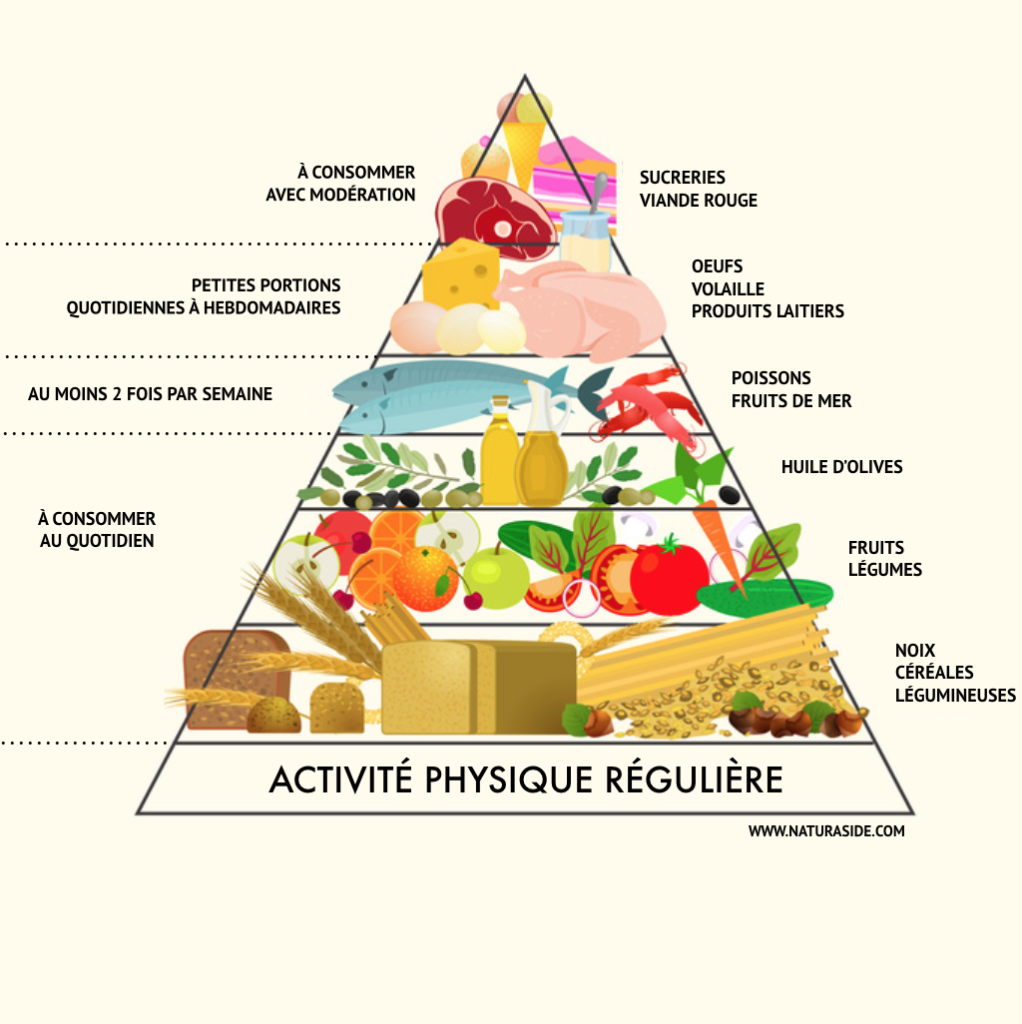
This premise may be unsettling to many an enlightened reader of this guide: how can cereals, which have been blamed for so many ills in the mass diet, finally become a health food that can be considered a staple of every meal?
This content is part of the guide Blooness, the guide to the ideal human diet, the summary of which you can find here 🌱🥑
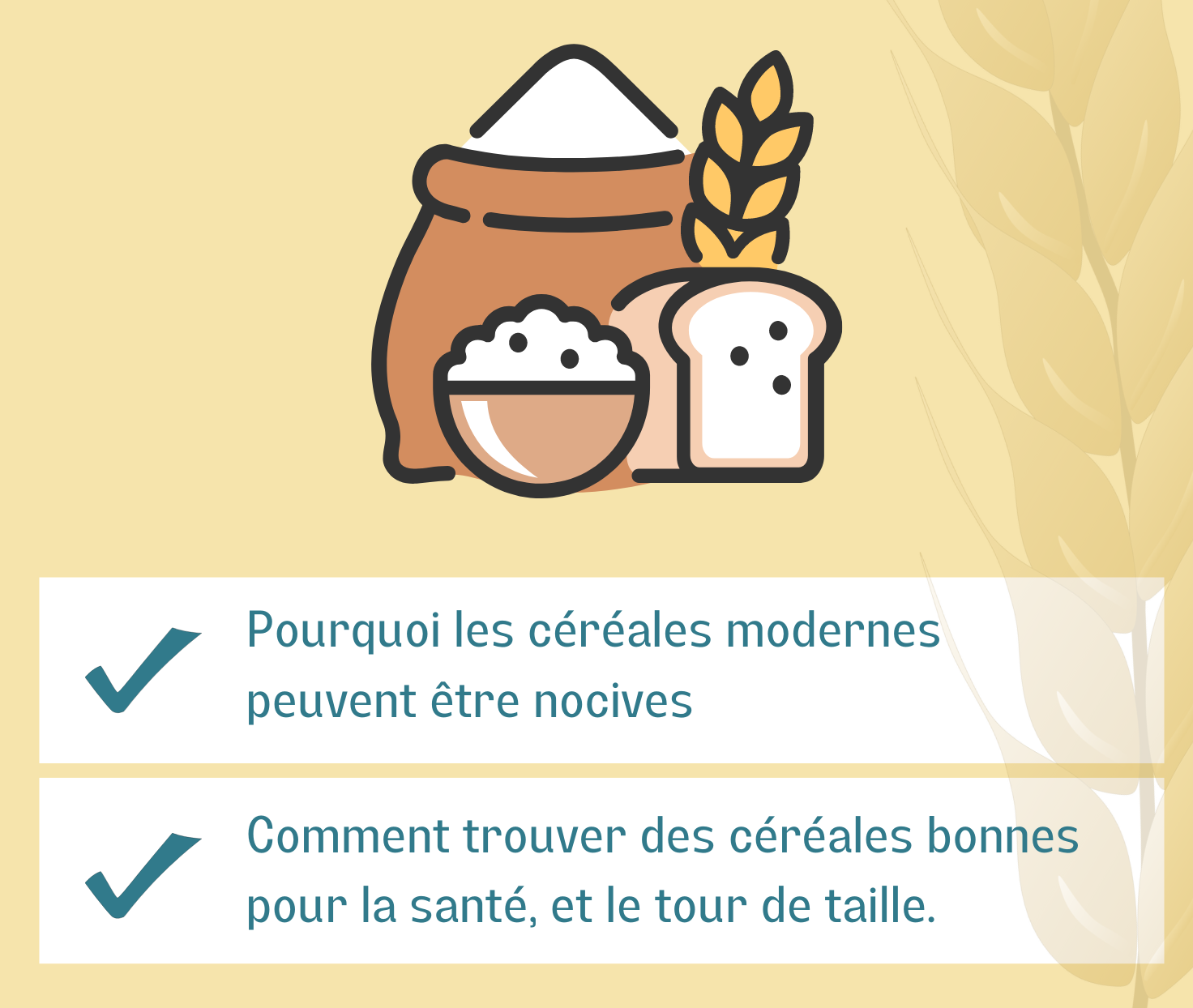
That's the question we're going to try to answer here, and more importantly, we're going to see that things aren't quite as simple as that.
Definition of a cereal
Cereals are mainly plants grown for their grain. It includes : wheat, barley, rye, maize, oats, rice, sorghum and many others.
French-speaking subscribers will receive the newsletter in French, and all others will receive an English version.
Some plants, such as buckwheat and quinoa are pseudo-cerealsAlso cultivated for their grain, but not belonging to the poaceae, the cereal family. Buckwheat, for example, is a member of the Polygonaceae family, while quinoa and amaranth belong to the Amarantaceae family, but that's a matter of nomenclature.
The aim is for these plants are grown for their grain, which is generally consumed as a source of energy and are often considered comfort foods.
Cereals, friend and foe
Originally, cereals were our best friends. They are what enabled human beings to improve their quality of life, via the birth of agriculture, which provided affordable energy.. Once hunter-gatherers, human beings truly emerged thanks to cereals and agriculture in the Neolithic period, becoming sedentary around 10,000 years ago.
That's how our ancestors created the first vegetable gardens: from hunter-gatherers, they became farmers and thus much less dependent on the vagaries of nature and the food available in a purely natural way. In their gardens, they grew cereals, such as barley, wheat, rye or millet. It was in the Middle East that these first crops appearedBut other civilizations emerged through the mastery of agriculture, notably Central America with the cultivation of maize, and Southeast Asia with rice.
The problem is that human beings have a natural tendency to optimize survival, limit energy expenditure and improve comfort. What was once an advantage may now be a disadvantage for our health.
From the Neolithic our ancestors had to cultivate the land to feed themselves, in a natural way, with the tempo imposed by nature and a sometimes unfavorable climateToday, we've moved on to a new way of life. totally sedentary and hyper-comfortableAnd we subcontract mass farming to industries that are driven by yield imperatives to meet global demand.
In other words, not only do we no longer need to physically exert ourselves to cultivate the land - so we move less - but the wheat we consume is grown for yield, via industrial processes that speed up the cultivation of cereals, even if this means going faster than the music, with all the consequences this could have on our health.
Spending less could be one of the 21st century's illsFor a variety of reasons, which we'll cover in detail in a separate chapter, but more than that, our digestive system may not have adapted to industrial processes developed in the 20th century to meet the huge demand for food. There are two problems here, which we're going to develop a little further.
High-GI cereals eaten in excess
The first problem is that we have become accustomed to over-consuming these energy-saving productsThey are accessible and often highly addictive. Perhaps our appetite for foods rich in carbohydrates is explained by the precious energy they provide, energy that was once scarce and therefore much sought-after by human beings.
As a result, if we refer to the caloric balance theory, which has been criticized but is nonetheless relatively applicable, we burn far fewer calories than in the past, but take in far moreand, what's more, it mainly involves carbohydrate-rich caloriesThese products provide energy that can be quickly assimilated, such as French fries, white bread and baguettes, high glycemic indexWe're too sedentary, which overloads the body with fat reserves and other health concerns, such as allergies, migraines, inflammations, headaches and sometimes even autoimmune diseases.
And to top it all off, some of the mainstays of the modern diet - most of which are over-processed - combine low-quality carbohydrates with high levels of sugar. lipids of poor quality, such as Viennese pastries, which is a double whammy that's bad for both your figure and your health.
So if we go back to the standard modern diet, eating sliced bread in the morning with jam, spread and orange juice, followed at lunch by a burger and fries or a baguette sandwich or a pasta dish, then a snack of pastries or cookies, and finally a pizza in the evening, we're at 200% in a carbohydrate-rich diet at glycemic index high, combined with too high an intake of lipids of questionable quality - as opposed to the good fats found in olive oil, salmon or avocado, for example - and overly processed foods, all of which is a pro-inflammatory, pro-metabolic disease, pro-overweight cocktail in the long term.
Cereals transformed by industry
The second problem posed by mass farming is that, in seeking to meet demand, the industry has worked to increase productivity, even if it means mutating the wheatwith all that this can entail in terms of health risks.
Strictly speaking, these are not GMOs, but rather selection of the most resistant wheats, crossbreeding of natural wheats, to produce more profitable wheats. In this way, we have gone from a 14-chromosome DNA for ancient wheats (e.g. wild einkorn, domesticated einkorn or small spelt)The chromosomes of the wheat family increase from 1 to 28 chromosomes for durum wheat (used to make pasta, poulard wheat, Polish wheat, Khorasan wheat, Kamut or Khorasan), then finally to 42 chromosomes to give soft wheat (or wheat), spelt (or large spelt).
Nature originally made crosses, but slowly and - by definition - naturally. It took a long time. Man has accelerated these crossbreeding processes, seeking to increase yields. For example, dwarfism genes have been widely used in wheat breeding since the 1950sThis was due to the fact that small-sized wheat had a much higher concentration of matter in its kernels. And yet, these modern types of wheat have little in common with the ancestral, totally natural wheat of 10,000 years agoThere are no real studies on the digestibility of modern wheat and, above all, on the medium- and long-term consequences for our health.
Without accusing anyone, but as a clue, it was in the second half of the 20th century, with the rise of sugar on the one hand, and cereals on the other, that the rate of cardiovascular disease increased, as did obesity, but also problems of food intolerance, celiac disease, and many other concerns.
And it's not just crossbreeding that's being criticized, but also bread-making techniques, and hence the processing rate of cereal products. In the past, bread was made with natural leaven.which is a slow fermentation process. To keep up with demand, bakers have had to adapt, using industrial lifting techniques to speed up the process.
Thus, the type of fermentation, the duration of fermentation, the type of cooking, the type of crushing of the grains to make flour, the extraction rates, the assembly of batches, the addition of chemical agents, preservatives, etc.... are all factors that could also have a major impact on consumer health..

It's not a question of blaming the manufacturers. If we look at the problem purely objectively, and not from the ivory tower of those who can afford to consume high-quality, expensive organic products, industry and public authorities have sought to address the issue of access to food. In other words, there was a demand, and this demand had to be met, firstly because this is the very nature of a profit-making company, but also because a solution had to be found to the problems of famine.
By finding a way to make cereals accessible and easy to grow, they helped prevent many tragedies in poor countries in the 20th century. But like the sugar industryBy giving the world's population access to low-cost food, we have certainly helped to avoid hunger in some cases, but we've probably overdone it and created another health problem.which has resulted in what is commonly referred to in this guide as diseases of civilization, with blue zones spared in proportionThese include diabetes, certain cancers, inflammatory and cardiovascular diseases, as well as relatively benign but nonetheless troublesome conditions such as intestinal inflammation and gluten intolerance.
Towards an ideal diet, including cereals and starches
It's in this sense that the champions of a low-to-moderate carbohydrate dietranging from ketogenic diet to the low-carb dietbut also diet practitioners paleohave found a solution to their problems, with fairly immediate results. By removing or limiting their intake of "mainstream" carbohydratesWe're committed to providing our customers with the highest quality food products, such as those found on supermarket shelves at affordable prices, with a focus on quality protein and lipid intakes, they found they were back to a healthy weight, and avoided their usual discomforts.
However, many of them recognized that once the carbohydrate elimination phase was over, it might be wise to gradually reintroduce high-quality carbohydrates. And that's how we can create a bridge between paleo / low carb diet and Mediterranean diet (with touches of ingredients from other blue zonesas Okinawa), and it would seem that this blend of best practices is the ideal health mixWe'll be coming back to this subject later, while respecting individual tastes and intolerances, which are sometimes a function of our genetic heritage, but also of the eating habits that shape our intestinal flora.
It's easy to see why in certain blue zones, people eat starchy foods and cereals, and remain in Olympic health well into old age These cereals don't have much in common, neither in quantity nor in qualityIn addition, they are not eaten in combination with processed ingredients rich in trans-fatty acids, or with fast sugars from processed products. What's more, they are not consumed in association with processed ingredients rich in trans-fatty acids, or with fast sugars from processed products.
This long parenthesis was very important to make, because it allows us to understand what happened in the past objectively, without entering into a passionate and committed debate, and therefore to try, when it comes to choosing your carbohydrates, and in the case of this chapter, when it comes to consuming cereals or pseudo-cereals, opt for the healthiest ones possible.
To do this, we simply take up what is consumed in blue zones - a fortiori in Mediterranean zones - in terms of cerealsby cross-checking the information with cereals that are actually better for your health, i.e. those that are both as unprocessed as possible, and as similar as possible to the cereals of yesteryear.
But before we get to that listing, let's take a closer look at how cereals have evolved over time, and wheat in particular, because as always in this guide, it's all about tackling subjects in depth to understand what's at stake. And by understanding how wheat has evolved over the fi
Wheat trends
The origins of our civilizations are linked to the domestication of wheatover 10,000 years ago, in what is now the Middle East. The domestication of a plant involves develop morphology and anatomy through cultivation and genetic selection. In practice, we collected the grain of wild plants whose characteristics interested us, sowed them, and the next generation thus possessed the selected characteristics. Yields were improved by crossing the most productive and resistant wheats..
Understanding cereal morphology
A cereal plant is made up of several spikeletswhich contain a greater or lesser quantity of grain. The challenge for human beings was to select the plants whose spikelets were the most profitable, i.e. those containing the most grain.
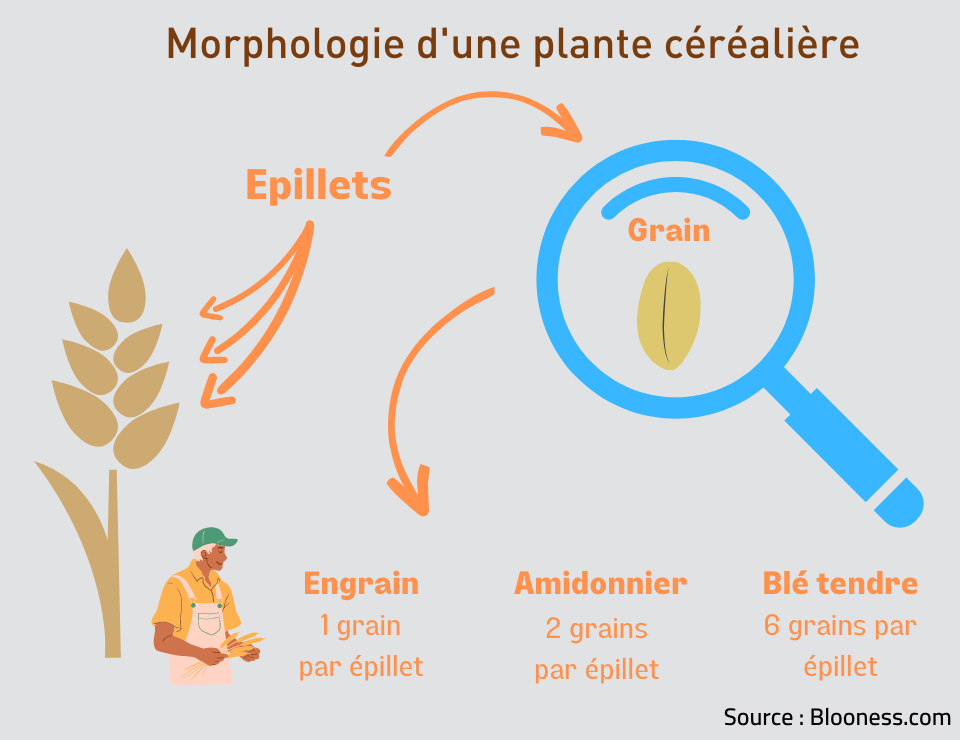
Each grain has a husk (the bran), an endosperm (the kernel) and a germ.. During the refining process, the husk and germ are usually removed, leaving only the kernel.which is the main ingredient of a wheat seed, for example, and which will be used in preparations.
But in doing so, we dispense with the husk and germ, which contain no starch and therefore little or no energy for the body, but which still have a very important role to play. interesting nutritional propertiessuch as containing proteinslipids and minerals and vitamins, and above all fibers if they are not metabolized by the body, slow down the passage of starch into the bloodstream, thus lowering the glycemic index.
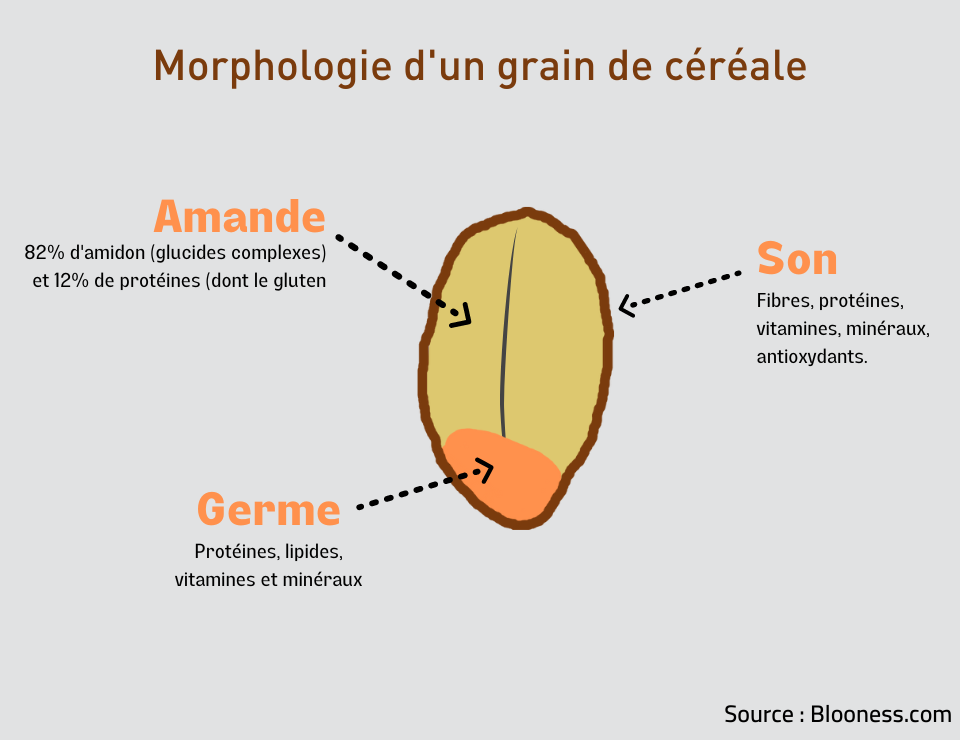
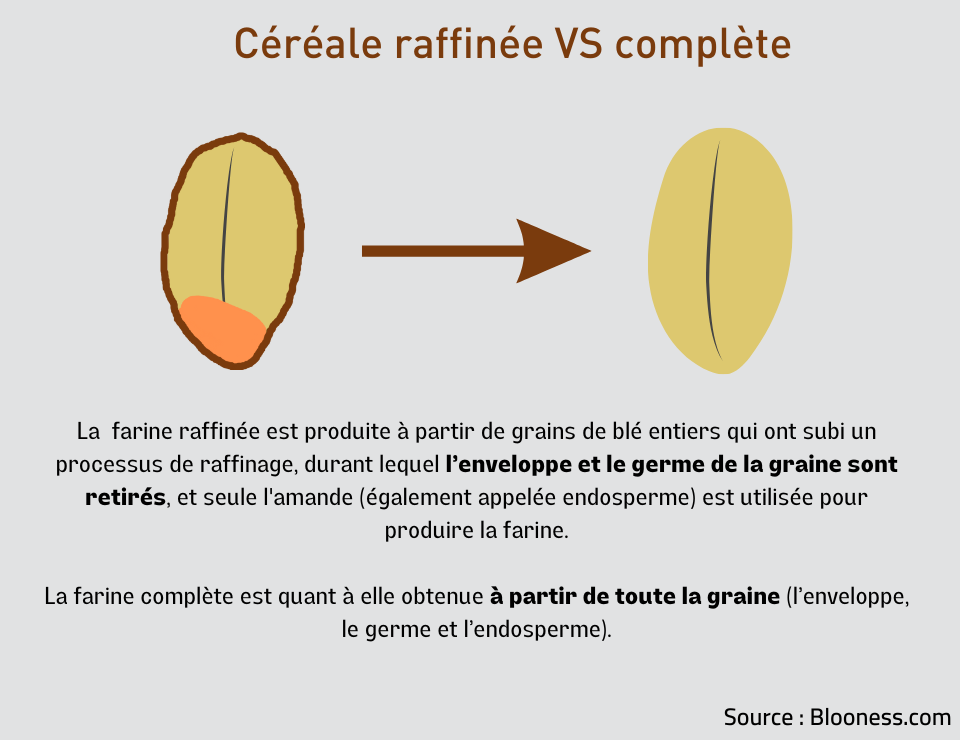
It is in this sense that whole wheat flours contain more interesting nutritional properties than refined flours. So, rather than opting for everything processed foods rich in low-quality cereals (white bread, rusks, industrial sandwich bread, sweet cereal bars and other morning cereals dipped in cow's milk), wholegrain cereals are an interesting alternativeand the Mediterranean diet is an example of what should be favored in this family of foods.
But refining is not the only factor, because as we mentioned earlier, it all started with human selection of the most profitable cereals. To better understand the evolution of wheat and cereals, we need to go back to Neolithic times and the beginnings of agriculture.
In the early days, einkorn or "petit épeautre
More than 10,000 years ago, bread was made from wild cereals, which were more or less easily assimilated by the body.
One of the first cereals to be domesticated by human beings 8,000 years ago would be Einkornalso known as small speltwhich is thought to have existed in the wild for over 500,000 years.
This species of plant is from Mesopotamia and Anatoliawhere it existed in the wild. In fact, one of the characteristics of wild einkorn is that the seeds fall to the ground when they reach maturity. This natural process ensures the survival of the species.
However, a mutation that was detrimental to the plant in some wild engrains prevented the seeds from falling: they therefore oxidized on their stems, causing them to rot. This was detrimental to the plant's survival, as the seeds rotted in their husks, but an advantage for the farmer who no longer had to pick them off the ground, but just cut the ears.
The first farmers therefore took advantage of this genetic particularity, and thus began to select and cultivate einkorns with this "defect".. This episode is considered to be the first act of human domestication of cereals, which paved the way for cereal farming.
Small spelt has undergone little processing over time, and is one of the least "profitable" in terms of productivity, as the spikelets bear very few grains, and the grains are small and coated, making them difficult to work. Their yield is estimated at 1,200 grains per m2. In fact, this is precisely what we'll be looking at next, as we return to ancestral cereals that are less refined, more natural and far more interesting from a nutritional point of view than the refined wheats considered profitable, often lacking in fiber and vitamins.
Wild and cultivated starch trees
At the same time, a probably natural cross between Sears' egilope (another type of wild cereal dating back over 500,000 years) and another grass gave rise to the wild starch plant, around 13,000 BC.
Around 10,000 B.C., humans succeeded in cultivating this wild starch plant, giving rise to the cultivated starch tree. Here again, the grains are dressed and few in number, but the ears are hardier than those of wild starch or wild einkorn, and they are more resistant. grains are also larger.
Durum wheat
Next comes durum wheat, which appeared 6,500 years ago. Its ear no longer breaks, and man has selected it for its large kernels.. What's more, the seeds are practical because they are naked, making them easy to eat. The fine leaves covering the seeds are easily removed, and the spikelets each have more seeds.
It is often used to make semolina, bulgur or pasta. Its yield is estimated at 15,000 grains/m2.
Soft wheat
Still around 6,500 BC, humans began to cultivate what we now call soft wheat, also known as wheat. It has the same characteristics as durum wheat, and is mainly used to make flour.

Spelt
Not to be confused with petit épeautre, spelt probably appeared around 6000 BC, and is the result of a possibly natural cross between einkorn and egilope in cultivated fields. It is sometimes considered a subspecies of wheat (i.e. soft wheat), but differs from the latter in the following ways its grain remains coated, unlike soft wheat whose grain is naked.
Today's hybrid wheat
A recent development, hybrid wheat is the result of crossbreeding several cultivated wheats, and benefits from very modern farming techniques, enabling much higher yields than before. Their yield is estimated at 48,000 grains / m2.
In short, a wheat that has evolved (too) quickly
This "Neolithic revolution", at the origin of our civilizations initially occurred in what is known as the Fertile Crescent or Levantine NucleusThe region stretches from present-day Israel to Iran, via Lebanon, Syria and Turkey. This enabled people to enjoy a more comfortable lifestyle, with access to a consistent and relatively stable food source, compared to the hunter-gatherer period.

After domesticating wheat considered natural, from 8,000 B.C. to the present day, mankind has continued to create "unnatural" wheat through genetic selection.
This is what gave rise to hard wheat and soft wheat, after numerous crosses.. These new types of wheat are characterized by higher yields - particularly thanks to their naked grains, which make post-harvest work easier - and greater resistance diseases.
As you can see, today's wheat has evolved very rapidly, and differs from ancient wheats, which raises the following question: has our body had time to adapt to this transformed modern wheat?
From wheat to other cereals
Humans have also cultivated barley, one of the first cereals to be grown, along with einkorn and starch.
Barley was first cultivated in the Fertile Crescent and northeast Africa around 15,000 years ago. In ancient times, barley was used to make beer in microbreweries in Egypt and China, around 5,000 years ago.
Barley was cultivated in ancient Greece, Carthage and even as far east as Finland in 4200 BC, as well as on the Korean peninsula around 1000 BC.
Millet was also cultivated in Central Europe, along with oats, around 2,500 BC, mainly as horse feed.
There was also rye, much later than wheat, which was widely used in the Middle Ages.
In parallel universes, in other parts of the world, human beings were able to domesticate other types of cereal. This is the case for corn in AmericaCultivated probably around 7,000 BC according to archaeological excavations, it was the staple food of the great pre-Columbian civilizations: the Incas, Aztecs and Mayas.
This is also the case for millet in northern China.around 10,000 BC, domestic rice monitoringaround 5,000 years ago, or the sorghum in Africa.
Pseudocereals
In addition to cereals, human beings have also cultivated pseudo-cereals, which do not belong to the same botanical family but which whose purpose was to cultivate plants for food..
These pseudo-cereals include quinoacultivated for over 5,000 years in the Andean highlands of South America, and like corn, was the staple food of pre-Columbian civilizations.
Gluten-free quinoa didn't interest the Spanish colonists, and it was only towards the end of the 20th century that the Western world began to market it en masse, notably for its interesting nutritional qualities, to which we'll return later.
Still in America, we also find amaranthanother pseudo-cereal, also gluten-free. In Central and South America, pre-Columbian civilizations cultivated it to consume its seeds (as a cereal: roasted, boiled, ground...) and its leaves (cooked, like a green vegetable). For the Mayas, Aztecs and Incas, amaranth was an essential food, on a par with quinoa.
Still in the family of gluten-free pseudo-cereals, we also find buckwheatbuckwheat, another superstar among carbohydrate foods. Buckwheat is mainly used as a flour, commonly known as buckwheat, and originated in China. It has been cultivated there for as long as 7,000 years in East Asia, where the oldest traces of it have been found, and was introduced to Europe by the Crusaders in the 15th century.
As you can see, the history of civilizations is based on control of food production and energy production. Since then, cereals have been one of the keystones in the development of civilizations, nations and empires. And to enable human beings to develop, they have not hesitated to improve crop yieldseven if it means accelerated genetic selectionwhich gave rise to new types of wheat more quickly than if nature had taken care of it alone.
The hypothesis put forward by certain emerging nutritionists concerning recent civilization diseases is that human beings would not have had time to adapt to these new types of wheat. They therefore advocate a return to "wilder" and more ancient wheats, which we will now attempt to list. It's a hypothesis that we haven't yet been able to verify, but it's worth taking the precautionary step of trying to significantly modify one's dietary choices in terms of cereals, a fortiori for those who have chosen to limit their carbohydrates - the refined carbohydrates of the modern diet - as these have done them more harm than good.
Let's take a look at the best cereals to eat for good health, based on the principles of the Mediterranean diet.
How to choose healthy cereals compatible with the Mediterranean diet
When it comes to returning to ancestral cereals, the type of cereal is not the only factor to consider. The way cereals are grown first and foremost, then processedalso needs to be taken into account.
First criterion: organic farming
It's important to opt for organically grown cereals, because there's no point in trying to revive an old-fashioned wheat if it's full of pesticides. So choose organic cerealsMediterranean food is by definition based on organic farming.
In addition to the way in which cereals are grown, we also need to take into account the stage at which the grains are processed by man. Let's take the example of bread, covered in the chapter dedicated to it..
Second criterion: unrefined flour
The problem with most modern breads, whether industrial or bakery, is that their glycemic index is too high. In other words, they cause blood sugar levels to rise too quickly, leading to a spike in insulin, the hormone that regulates blood sugar levels. This repeated phenomenon can lead to the excess glucose circulating in the blood being stored as fat, to fatigue after the insulin spike followed by reactive hypoglycemia, and to a wide range of health problems linked to chronic inflammation and overstressing of the body.
This is particularly true of rusks, white baguettes, industrial sandwich loaves and Viennese pastries.. This changes the glycemic index of a bread made from cereals such as wheat, firstly, the wheat or cereal or pseudo-cereal chosen to make the bread. Flour made from ancient wheat such as petit épeautre, or rye flour, will have a GI of 40 to 45, whereas bread made from standard white flour will have a GI of 70. This is due to the "slower" assimilation of small spelt, which contains more fiber and micronutrients than more rapidly assimilated modern wheat. This brings us back to what was said at the beginning of this chapter about the type of flour selected.
But the choice of cereal is not the only criterion. GI also depends on the refining and processing that the food may have undergone (grinding, blending, crushing, etc.).. The more a food is mechanically processed, the more the structure of its fibers and starch particles is modified, and the higher its GI. For example, more refined flour has a higher glycemic index than wholemeal flour..
But here again, it's all a question of balance. Some people find it more difficult to digest certain types of whole, ancient wheat, because their whole grains contain nutrients that are difficult for the body to assimilate, whereas the "naked" grains of today's durum wheat or hybrid wheat - also known as soft wheat - are more or less easily digested, regardless of the health concerns they may cause some people.
3rd criterion: Sourdough bread VS yeast bread
When it comes to bread preparation, another factor seems to work against modern bread, is baker's yeast. Normally, to make bread, we need flour (wheat flour, for example), water, salt and natural sourdough.
Sourdough is the natural fermentation of cereals and water.Like grapes for wine, it eventually matures to produce the final product. The leaven consists of lactic acid bacteria that develop in a mixture of flour and water, and feed on the wheat starch. The gas extracted from this fermentation phenomenon remains trapped by the wheat gluten, causing the bread to "rise".
A little sourdough can then be reused from one preparation to the next, and the microorganisms multiply to produce bread.
The trouble is, it all takes time.. To improve productivity, mankind has been using baker's yeast since Antiquity.which is a blend of different strains of Saccharomyces cerevisiae, a species of yeast used in beer fermentation.
The advantage of yeast is that it is much more efficient and predictable than sourdough.. On the other hand, it produces less dense breads without the acidic aftertaste characteristic of sourdough bread. Bakers' yeast should not be confused with baking powder, a mixture of sodium bicarbonate and tartaric acid that produces carbon dioxide when added to baked goods. It can be found in supermarket aisles and is used in the preparation of pastries.
Coming back to baker's yeast, its main concern is that it increases the rate of bread transformation, and raises its glycemic index, unlike sourdough, which is a slower, more natural lactic fermentation.
Bread is often singled out as an example of carbohydrate of poor quality because of its generally high glycemic index, much to the dismay of bakers who defend old-fashioned, sourdough-based production without additives. Sourdough has the advantage of reducing this glycemic index by attacking the chemical structure of its starch.
So, for the same calories, a slice of sourdough bread will probably have a lower weight impact than yeast bread, but will above all have a higher nutritional value. Another advantage of sourdough is that it neutralizes gluten toxicity..
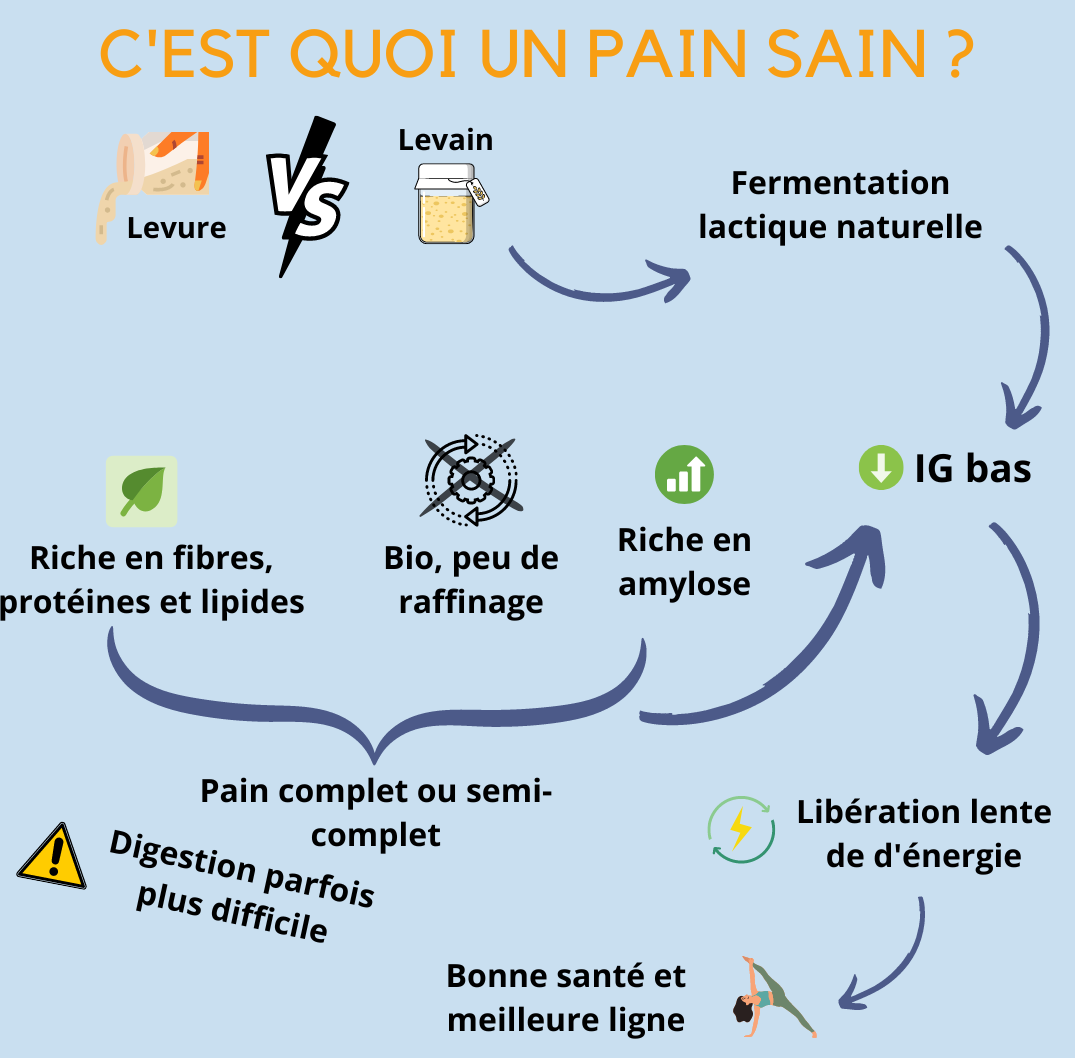
In other words, a sourdough bread will be healthier than a baker's yeast bread. However, here again, we shouldn't necessarily incriminate bakers, who have simply responded to a growing demand. In the 50s, bakeries needed at least 8 hours to produce bread. Today, industrial bakeries produce bread in less than 20 minutes. While today's breads are far more chemical than their predecessors, they are also more affordable, which is no bad thing.
In the context of an ideal diet, the question then arises of consume less, but better. And in the Mediterranean diet, and even in the low-carbBread, cereals (as we'll see later) and legumes can be used as a base for certain meals, but as a precautionary measure, we prefer cereal flours that are more or less ancient, as little processed as possible, organic, and in the case of bread, bread made with sourdough and quality flour, or a mix of quality flours and seeds.
First, let's take a look at which are the healthiest Mediterranean-compatible cereal flours? We'll then look at the best cereal starches for your health, to accompany your recipes and dishes.
Top healthy flours for the Mediterranean diet
Cereals are very often cooked in the form of bread, which is one of the flagship foods of the Mediterranean diet. Not bread made with white flour, nor sweet bread pudding, but quality bread, often rustic, made with sourdough and wholemeal or semi-wholemeal flours.
Let's take a look which breads and flours can be counted among the best? that respect the standards of the Mediterranean diet.
Wholemeal sourdough bread
In the family of cereal ingredients, forget white bread, white baguettes, morning korn flakes and other industrial sandwich loaves.
When you want to maintain or introduce carbohydrates into your diet, you can start simply by choosing quality bread, such as sourdough breadbased on wholegrain or semi-complete cereals, generally unrefined. Wholegrain or semi-complete bread is the best-known example. There's also wholemeal breadwhich is produced with flour that has not been refined, thus retaining all the cereal's constituents.
Wholewheat bread is a cereal that contains gluten, but has retained a good quota of vitamins and minerals. Its GI is moderate, between 40 and 50.
Wholemeal bread, which still contains gluten, has a low GI of around 35.
Rye bread
Rye flour contains ironfrom potassiumfiber, vitamins... One of the best alternatives to wheat flourIt does, however, contain gluten. Its glycemic index is between 40 and 45, which is considered low or moderate.
Buckwheat flour
Buckwheat is a pseudo-cereal, and this is where one of the best alternatives to wheat It's rich in fiber, protein and antioxidants. It has a low GI of 40.
Finally, contains little or no gluten.
Small spelt bread
Petit épeautre - or einkorn - not to be confused with spelt, is one of the oldest cereals. It is one of the least easy to produce, and is one of those with the greatest potential. superb nutritional qualities.
Small spelt is rich in "good" mono- and polyunsaturated fatty acids, minerals and vitamins (E and B). And more, its proteins contain the eight essential amino acids that the body needs, which is rare for a cereal. Next, small spelt contains very little glutenand is therefore easier to digest.
Small spelt has a low GI of around 40such as buckwheat flour, and constitutes a fine alternative to wheat flour. Its cultivation dates back to the origins of agriculture in the Neolithic era, more than 6 or 7,000 years ago. It was one of the first domesticated crops. Traces of it can be found in Provence as early as 7,000 BC.
Kamut flour bread
This wheat variety has among the oldestand is a cultivar of the Khorasan wheata cousin of durum wheat of Iranian origin that appeared 5000 years ago in the Mesopotamian fertile crescent. Khorasan is a region in north-eastern Iran. Its GI is 45This also makes it an alternative to basic bread, but it does contain gluten.
Essene bread
The name Essene bread refers to the Essenes, a people of Judea who, over 2,000 years ago in Palestine, prepared this food without cooking, simply by dehydration in the sun. Essene bread is thus obtained by first soaking the cereals to induce germination.
Once germinated, the grains are then ground to form a dough that ferments naturally, without ever being heated above 80°C. This absence of cooking preserves all the nutrients in the resulting bread.
This is also one of the healthiest breads, since yeast is avoided, and sprouting and baking multiply all the nutrients in your bread. It can be rich in flavonoids and fiber, depending on the choice of seeds. To make essene bread, you can choose any cereal you like for germination: from wholemeal wheat to small spelt, via pseudo-cereals such as quinoa, buckwheat or amaranth. It has a low GI of 35, depending on the seeds chosen, and can be gluten-free, for the same reason.
Pane vivo bread
pane vivo bread is made from an ancient type of durum wheat from Italy, leavened by an ancient leavening agent dating back 133 years. With a GI of around 49, pane vivo bread is made with organic (i.e. pesticide-free), stone-ground wholemeal flour (T150).
Cretan barley bread
Also known as paximadi bread, and used for the delicious Greek salad known as "Dakos", this Cretan bread is baked twice and is made from barley flour in particular. It's a bread with interesting nutritional properties, and is of course ancestral.
More generally, if you're interested in the subject of bread, I refer you to the hyper-complete chapter devoted to themwhich corresponds roughly to the bread consumed in the Blue Zones.
The question of gluten in cereals
As a reminder, gluten is a set of proteins that can be more or less well digested depending on the individual, and this is what gives a dough its elasticity. As we explained here, manufacturers have worked on numerous genetic crosses to increase the gluten content of wheat, in order to make dough more elastic and boost productivity.
They have also mutated the wheat to make it lower in height, for ease of processing. It is therefore assumed that these modern varieties of gluten-rich wheat are likely to cause inflammatory and immune reactions in certain individuals, such as digestive discomfort, migraines, ENT diseases and allergies.
To get around this problem, alternative, gluten-free flours can be added to traditional bread-making flours (those originally intended for bread-making). These can even replace bread-making flours completely in certain preparations, such as buckwheat, barley, corn, chestnut, walnut, etc. flours.
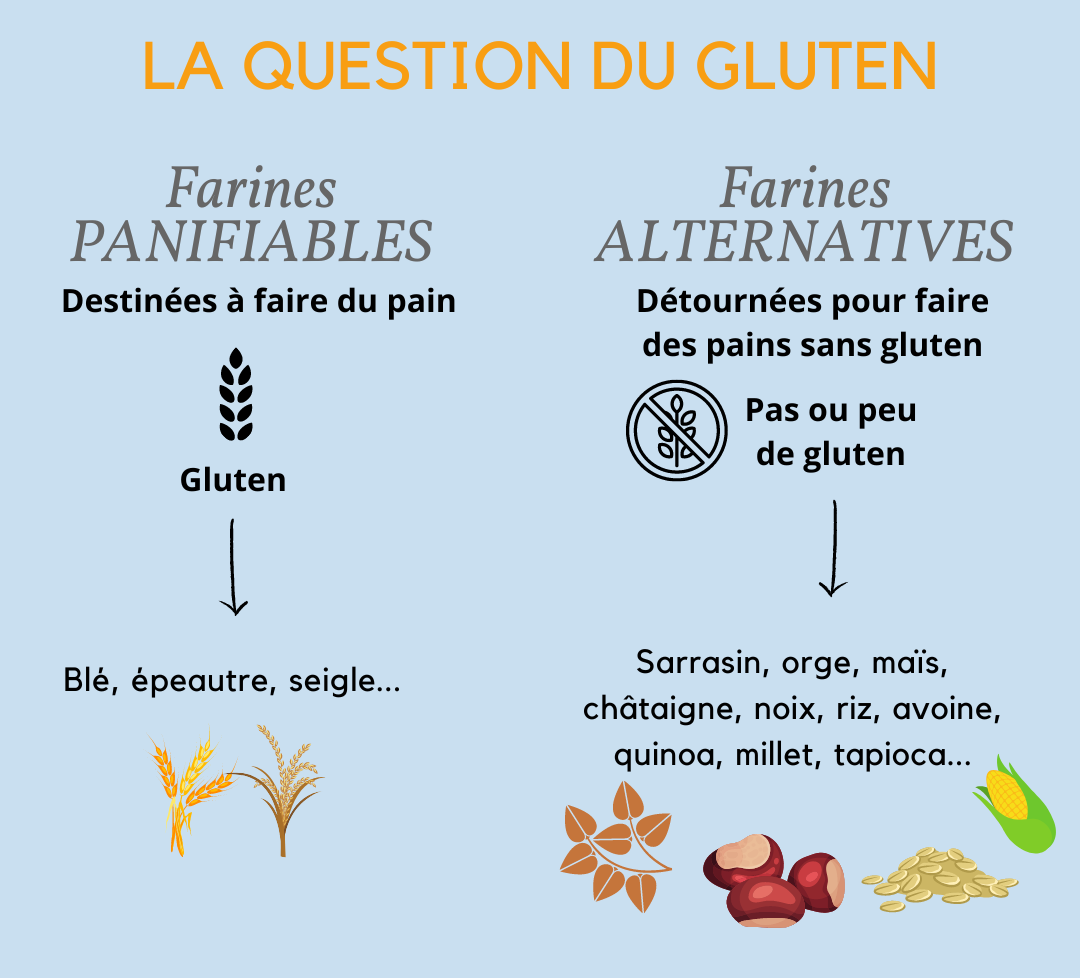
However, beware of the glycemic index when choosing alternative flours. If, for example, you opt for white rice flour, you'll have solved the gluten problem, but not the glycemic index or the relatively low vitamin and mineral content of white rice. We prefer healthy alternative flourswhich we will discuss below.
The best alternative flours
For culinary preparations of all kinds, if you choose the nutritional quality/gluten content/glycemic index ratio as your criterion, the following flours are to be preferred, in order of GI. Some of these are not cereals or pseudo-cereals, but have been diverted for use as flour.
- Oat bran (GI 15)
- Lupin flour (15)
- Almond or hazelnut flour (20)
- Hulled barley flour (30)
- Coconut flour (35)
- Chickpea or lentil flour (35)
- Buckwheat flour (40)
- Small spelt flour (40)
- Quinoa flour (45)
- Whole-wheat flour (45)
- Rye flour (45)
Now that we've dealt with the subject of flour and bread in practical terms, let's take a look at the practical side. what other types of cereals are used as starchy foods? and side dishes that are outstanding for their nutritional properties and health benefits, and are therefore by nature compatible with the Mediterranean diet.
Top healthy cereal starches in the Mediterranean diet
Whole bulghur
Widely used in Middle Eastern cuisine, notably in Syrian and Lebanese dishes (including tabbouleh, kebbeh and kishk), but also in Iraq, Armenia, Greece and, of course, Turkey, bulgur - generally semi-complete - is a preparation based on durum wheat - which has been stripped of its husk but retains its germ - pre-cooked in water, dried and finally crushed.
It can be mixed into recipes such as the famous kishk, or used as a starch to cook in water and then serve in place of rice, for example.
Bulgur is nutritionally similar to semolina (another by-product of durum wheat, but from which both the bran and the germ have been removed). In other words, bulgur is an intermediate state of wheat, between seed and semolina. Its main interest lies in its high carbohydrate content, which is a key factor in its health. moderate glycemic index of around 50-55and mineral content. Insoluble fiber lowers GI and regulates blood sugar. blood glucoseThey help to reduce cholesterol levels and facilitate intestinal transit. The betaine it contains has an anti-inflammatory effect..
Bulgur is generally semi-complete, i.e. without the bran, but there are complete versions, which retain part of the husk, favoring slow digestion and therefore better regulation of blood sugar levels and satiety, provided they can be tolerated. We prefer it in all cases organic.but like all cereals in general.
Semolina
Semolina is obtained by grinding grains of wheat, corn, buckwheat or rice. The best-known semolina in France and North Africa is wheat semolinawhich accompanies the famous couscous. More processed than bulgur, as it is ground and stripped of its husk and germ, durum wheat semolina logically has a higher GI of 70, which makes it a carbohydrate food to be tempered.
However, it is possible to prepare couscous with wholemeal durum wheat semolina, which retains part of the husk.
Wholemeal pasta
Wheat pasta is made from durum wheat, which is ground. Its endosperm is ground into a semolina, which is then mixed with water to form a thick paste that is passed through holes of various shapes to obtain different types of pasta. It's precisely the yellow color of the grain's endosperm that gives pasta its golden hue.
In the same "Mediterranean" vein, white pasta is prepared using only the endosperm, whole-wheat pasta is preferred - to retain the germ, bran and starch - or semi-complete pasta, to retain the maximum amount of nutrients and slow down the rate of assimilation.
Outside the spectrum of cereals, you can also try legume pasta, which in many ways resembles wholemeal pasta, but we'll deal with that in the chapter on legumes.
Brown rice
Unlike white rice, brown rice is a cereal whose bran and germ have been preserved. Wholegrain rice is harder to chew than white rice and goes rancid more quickly. It has more nutritional value because the rice bran is rich in various nutrients: fibre, vitamins B1 and B2. B6iron, magnesiumand potassium, while the germ provides fatty acids and proteins.
So the same logic still applies here, i.e. choose a wholegrain or semi-wholegrain cereal that is organic. And unlike wheat, rice is gluten-freemaking it a superb starch.
Quinoa
As we explained at the beginning of this article, quinoa is an essential ancient plant domesticated 3 to 5,000 years ago by the peoples of America, which has remained virtually unchanged. Pre-Columbian civilizations cultivated and used this pseudo-cereal as a staple of their diet.
Quinoa is considered a whole grain, but it can be ground or refined, like white rice or white wheat flour. It's an ingredient with many advantages, and a very good alternative to wheat, because it's gluten-free, and its nutritional composition is very interesting.
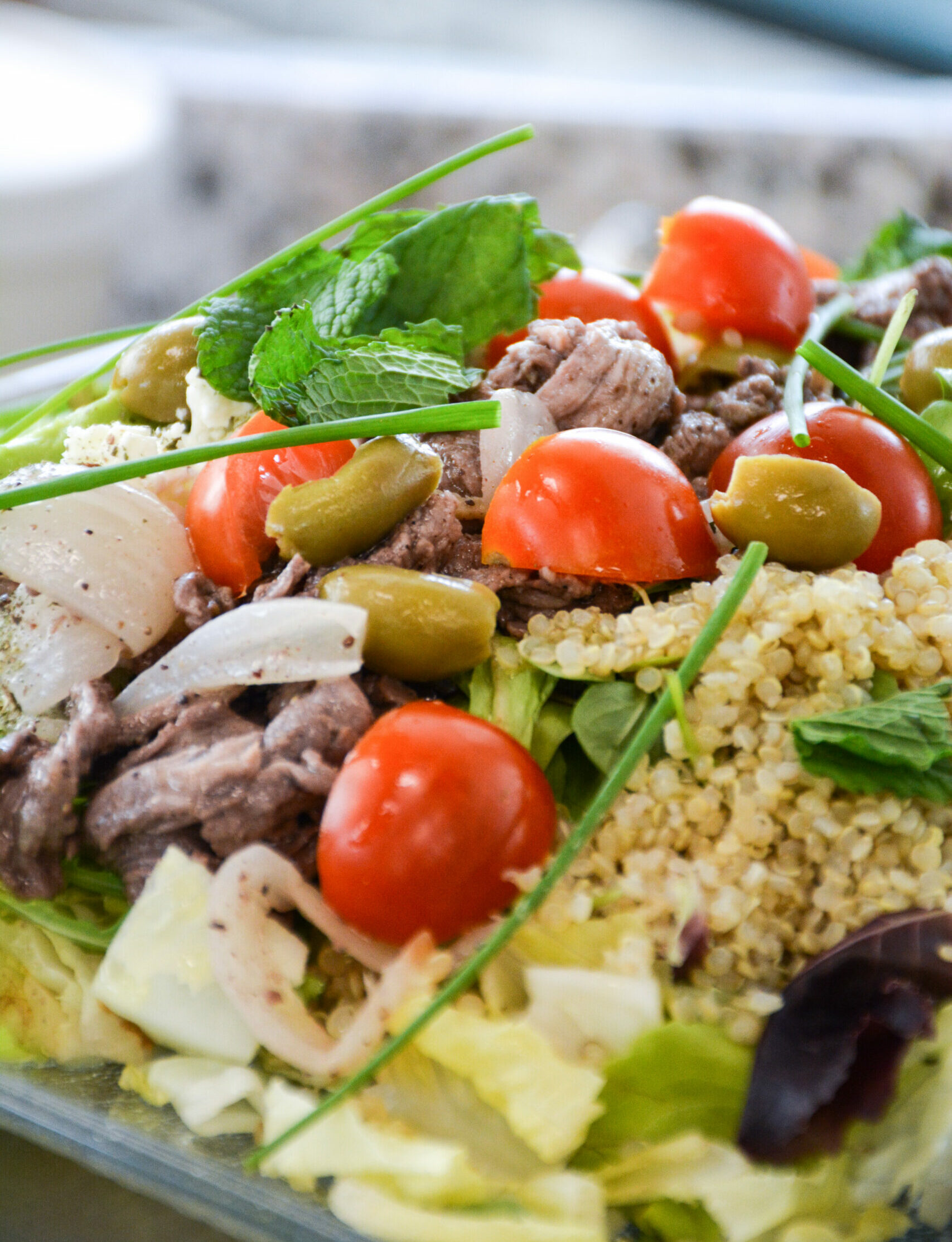
It is a protein-rich starch. it contains the 9 essential amino acids - and also rich in fiber, magnesium, B vitamins, and various antioxidants and flavonoids, which have anti-inflammatory and antiviral properties.
Finally, its glycemic index is 53which is a moderate GI.
Amaranth
Amaranth is a sort of cousin to quinoa. This ancient pseudo-cereal was also the staple food of American civilizations such as the Incas, Mayans and Aztecs.
Amaranth grains can be processed into flour as an alternative to wheat flour, and it has a remarkable nutritional composition. It is one of the plants richest in protein and in calciumand amaranth is rich in iron, linoleic acid, manganese and vitamin C.
Also gluten-freeIt is rich in phenolic acids, antioxidant compounds that protect against certain heart diseases and cancers.
Freekeh
Freekeh is a variety of durum wheat, picked before ripening and nicknamed "green wheat". The harvested ears are then lightly burned in their bark to stop the grains germinating and remove their husks, then dried in the sun.
The beans can then be used as is or crushed. Freekeh is very tender, with a fairly sweet flavor and a hint of smoke.
Widely used in Oriental cuisine for thousands of years, freekeh is an ingredient in many sweet and savory recipes. It can replace bulgur, rice or quinoa in most recipes.
If it contains gluten, freekeh is twice as rich in fibre as quinoa and three times as rich in protein as rice (15g per 100g of food), with a relatively low GI of around 43. It has a good iron content zincpotassium and calcium.
Barley
Just like rice, wheat and oats, barley is a cereal a member of the grass family. But barley is the cereal with the most the lowest glycemic index (GI of 25 for its least processed form, hulled barley, and 60 for pearl barley).
Pearl barley has had part of the husk, bran and germ removed. This form is quick to cook, but less interesting than hulled (or whole) barley, in which the barley has been stripped of its inconsumable cellulose husk, and is therefore richer in fiber, vitamins and minerals.
Barley is richer in fiber and micronutrients than wheat, its main competitor.
As we mentioned earlier, barley has been, along with wheat, one of the first cereals to be domesticated by manIt was first cultivated in the Middle East around 8,000 BC. It was cultivated both in the Middle East and on the banks of the Nile. Its cultivation then gradually spread to northern Europe and eastern Asia, reaching eastern Finland by 4000 BC, and Korea by the end of the second millennium BC.
We recommend eating it in the form of hulled barley.You can also eat the famous Greek bread that accompanies Dakos salad, often made with barley flour.
Just like wheat, barley contains gluten. It is an alternative cereal that promotes good digestion, thanks to its fiber content. It's also rich in B vitamins, calcium, magnesium and iron. seleniumphosphorus, iron, zinc, copper and magnesium. It's a superb alternative to refined wheat or white rice.
Millet
Millet has been grown in China for over 5,000 years. Its cultivation then spread to Asia and Africa, before arriving in Europe in the Middle Ages. A daily staple, it was later replaced by wheat, potatoes and rice. Today, millet is making a comeback for its nutritional properties.
It is gluten-free, highly digestible and contains a lot of protein. (up to 13g per 100g depending on the species), vitamins and minerals. Of course, it's also an excellent source of fiber, and can be eaten as grains, flour or patties.
Oats
Probably domesticated in central and northern Europe around 2500 BC, oats have been used for centuries to feed livestock, and more recently in human nutrition.
It has been democratized in the form of oat flakes or porridge, consumed in particular by athletes looking for a healthy source of complex carbohydrates with a relatively slow release, and therefore a rather low GI (around 40).
It's a cereal that's inevitably rich in fibre, which makes you feel full, and it contains gluten..
The least processed form of oats is cut oats, characterized by whole grains. Oat flakes, on the other hand, are obtained by cooking and then flattening.
Sorghum
Sorghum, which originated in Africa, is a gluten-free cereal whose grains are eaten like rice in India and Africa. Sorghum can also be ground into flour for cooking, and has a GI of around 65.
It's rich in phosphorus, calcium, iron, magnesium and zinc, and provides no less than 10g of protein per 100g, making it a good alternative to rice or durum wheat.
Conclusion on cereals in the Mediterranean diet
Quality cereals, at least semi-complete
From now on, healthy cereals will hold no secrets for you. When it comes to choosing your starch and cereals in your shopping basket, you'll no longer be limited to pasta, rice and baguette. You'll now know that you can vary the pleasures, and sometimes choose semi-complete rice, wholegrain pasta, bulgur, small spelt pasta, and why not sorghum or millet. And let's not forget legumes, which are a good alternative to cereals when it comes to choosing a starchy food.
The most important thing is to vary the sources as much as possible, and to listen to your body. If, for example, you feel that an ingredient is difficult to digest when it's whole, opt for the semi-complete version, and gradually increase the quantity until your body gets used to the new food.
Cereals to match your energy requirements
To answer the question posed at the beginning of this chapter on the merits of putting cereals back at the heart of the diet, it should be remembered that cereals are a source of energy (among other things, of course)so, like leguminous plants, or vegetables rich in starch, such as potatoes or sweet potatoes, enlightened gourmets - which you will become if you follow this guide - have a way of including them in their meals, and quantifying them, without abusing their quantity or frequency.
It should be remembered that the Mediterranean diet was conceptualized on the basis of observations made on active populations. By the way, sporting activity and social life are the epicentre of the lifestyle MediterraneanWe'll come back to this subject in a later chapter. That's why quality carbohydrates have their place in an active lifestyle, like the ancestral Mediterranean populations who often worked outdoors and were not sedentary.
Diet practitioners ketogenic or the paleo diet for example, are sometimes unsettled by the idea of being told that cereals are not incompatible with a healthy lifestyle. But then again, it's all a question of context, personal choice, taste, feelings and the time of life.
Indeed, some people - and we're one of them - suggest that ketogenic dieters shouldn't necessarily do it all year round, but rather in periods of 3 to 5 months, for example, alternating between ketogenic and a moderate diet of quality carbohydrates. This way, the body can "switch" from one substrate to the other, without being disconcerted by the change. However, it's a very personal thing, and should be done in the company of a healthcare professional.
And for those who don't want to go on a "zero carb" diet anyway, then the Mediterranean option will probably be the best choice for your health. But be careful not to fall into that famous gray zone, which includes both high levels of fat and carbohydrates, or you'll put on unwanted weight. Once again, in nutrition, it's all a question of dose and balance, and you need to know how to take pleasure from reasonable portions, like the Okinawans, whose diet recommends stopping before you're full, for greater longevity.
As explained above, you can set the cursor according to your tastes, lifestyle and goals. For example, a person who has reached a reasonable weight after a low-carb diet can gradually reintroduce healthy carbohydrates in the form of spelt bread for breakfast, and lentils for lunch, while at the same time reducing his fat intake, so as to get used to carbohydrates again. There's nothing to stop him returning to a ketogenic diet later, when he feels the need. In this way, the body is surprised and prevented from adapting each time, and thus from resting on its laurels. In any case, this fine-tuning between low carb and Mediterranean diet will be dealt with at the end of this large section dedicated to the Mediterranean diet.
In practice, how does the Mediterranean diet and its consumption of cereals fit in with our lifestyle?
In practical terms, to return to the subject of cereals and energy expenditure, a cereal in the morningBut you can do without bread at the second meal if your protein is already accompanied by a generous portion of legumes, for example.
In this way, we avoid the "double intake" of carbohydrates, especially as bread is often "addictive", and we tend to nibble on it indefinitely, to the detriment of our protein and good fat intake.
Once again, it's all a question of dosage, and sometimes you have to make choices to avoid excess energy. But don't deprive yourself if you're a keen sportsman or woman, or if you're having an exceptionally busy day.
In practice, cereals, legumes and starchy vegetables can be seen as an energy substrate, beyond culinary pleasure, and their dosage can therefore be revised downwards or upwards, either in quantity or frequency, depending on lifestyle, energy expenditure, stress, feelings, etc...
All these examples and tips are obviously general, and depend on your lifestyle, metabolism and tastes. The best guinea pig is yourself. And it's by trial and error that you'll find out when to consume them, and in what quantities.
Most people achieve good results when the intake of quality carbohydrates is occasional, cyclical, in the form of "micro-recharges". every 3 or 4 days, for example, and not necessarily set daily, morning, noon and night. Other nutritionists recommend taking cereals only at the start of the day, so that they can be used throughout the day, in accordance with the principles of chronobiology.
But what works for some, doesn't work for others. It's up to you to find your own rhythm. The most important thing is that this guide can now help you to name and classify these different food families according to your needs, so that you can quantify and plan for them, even if this is done in a more or less rough way. If there is no perfect method applicable to everyone, everyone can at least have a framework and knowledge of nutrition, in order to learn to eat better, and this is the very essence of this guide.
Now that we've covered the hot topic of cereals, let's move on to their energetic "cousins", legumes, which are also a source of slow sugars. This will be the subject of the next chapter, coming soon. See you soon!
Next chapter: Top healthy breads, when and how to eat them
Previous chapter: Spices, condiments and herbs in the Mediterranean diet

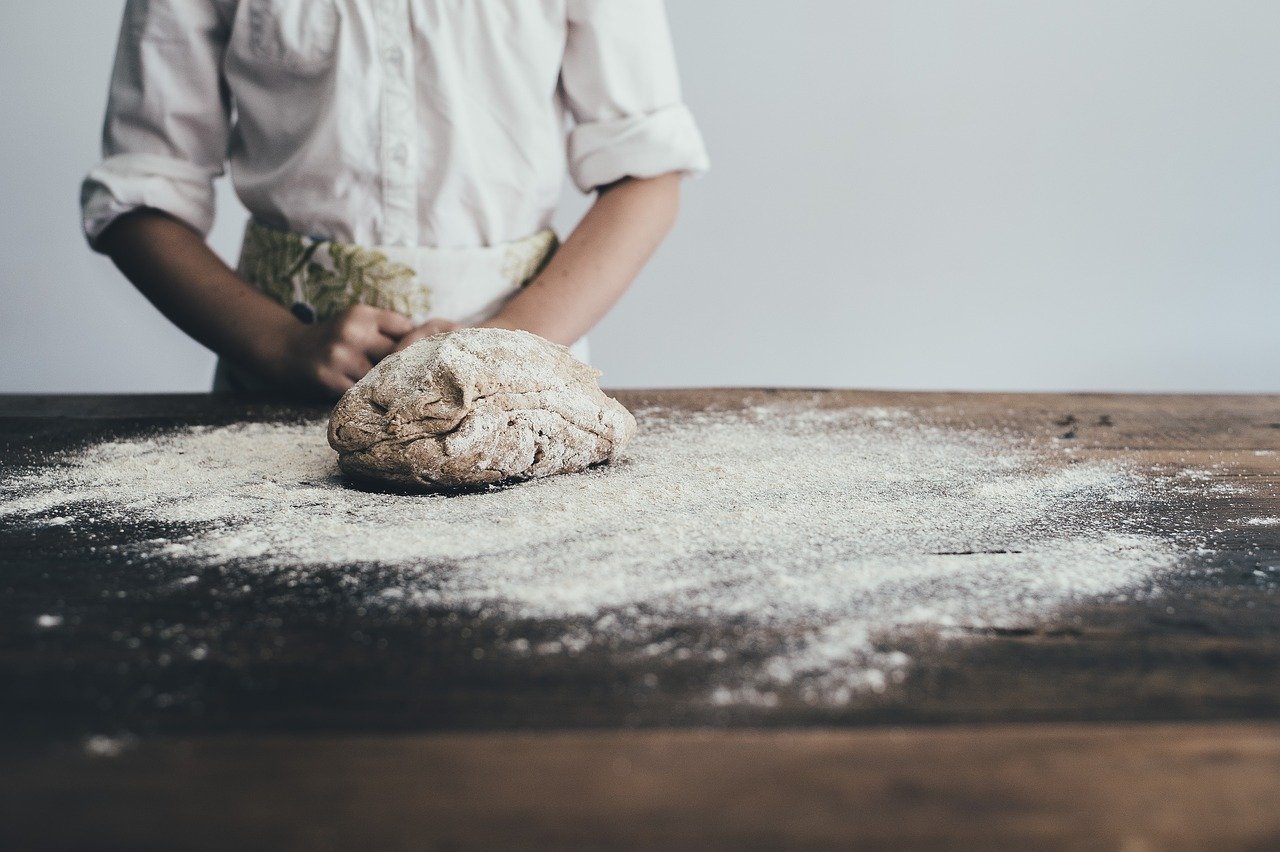
One Response
Nice but name some cereal brands to be acceptable .
Cheerios? Raisin Bran? Corn flakes?